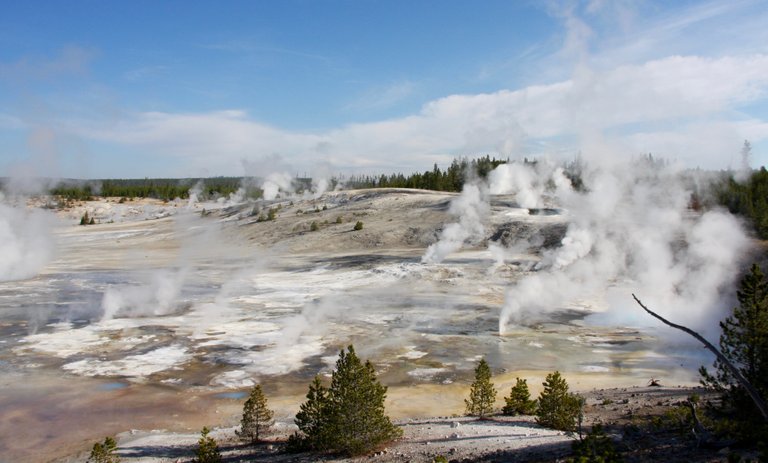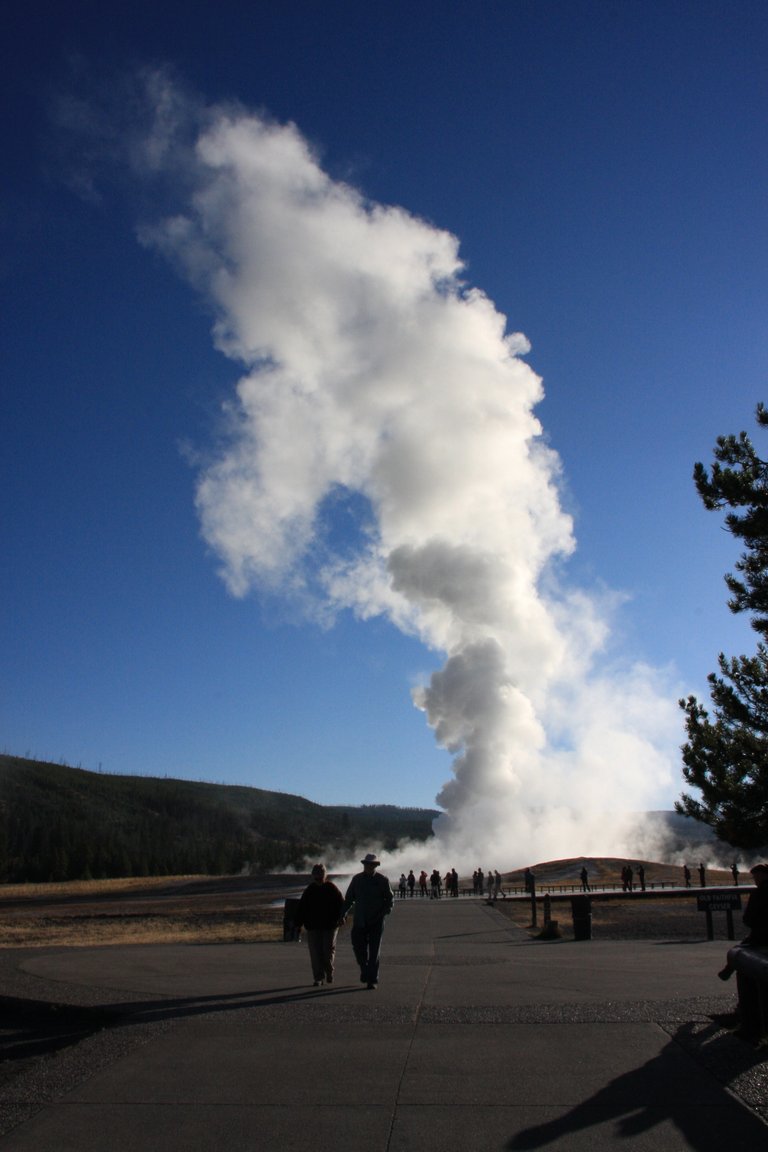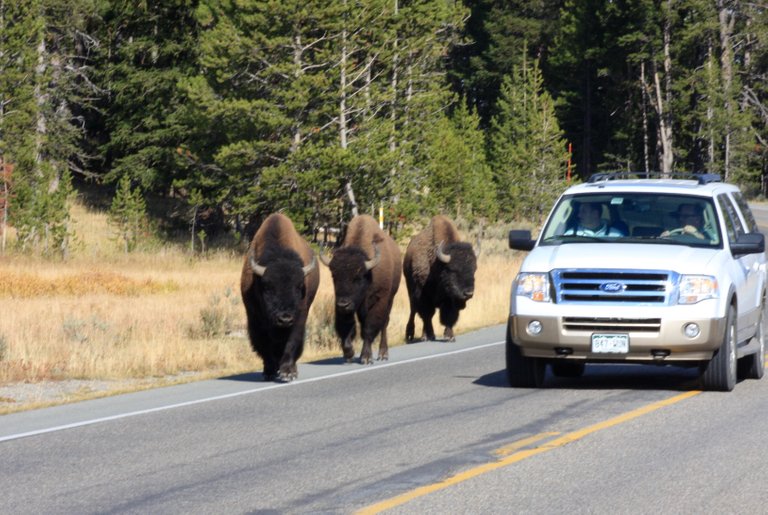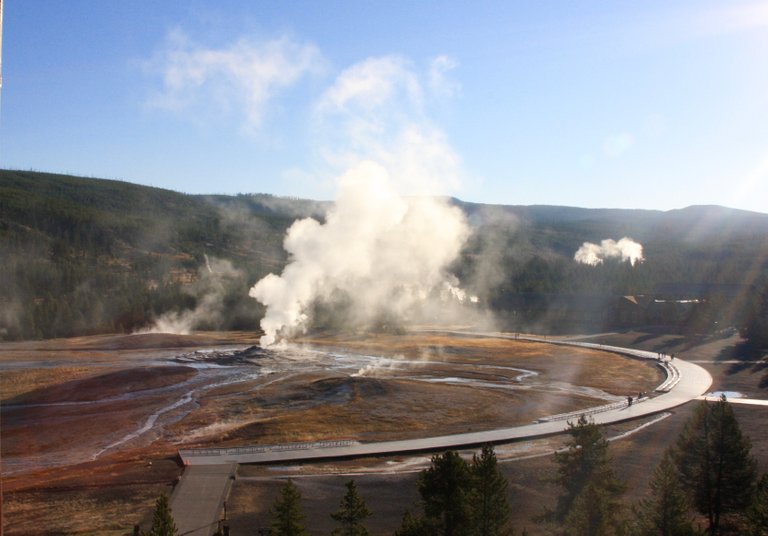Dusk was falling when we entered Yellowstone National Park. The crescent moon hanging just above the outline of the western mountains added to our expectation.
It is very much for reason of Earth’s heaving and puffing that still goes on there, as for the dramatic contours of what had been shaped over the ages, that this is the world’s oldest national park, having been declared so by the government of the United States back in 1872.
We saw a white wisp of steam in the darkening veld a short distance from the road. Then another, and another. Soon it turned into a surreal landscape of steam rising from the ground.

A surreal picture is created by steam rising from a scorched geyser field.
Ahead, the red stop lights of cars indicated that something had been spotted. It turned out to be a mooze grazing in the marshes right next to the road. The traffic headed in the opposite direction formed a barely moving queue of more than a kilometre. It was what park rangers refer to as a “mooze jam”, as they do to a “bison jam”, and to elk and wolf jams.
Our driver, a South African tourism manager, shook his head. Traffic, he said, seemed to be the same headache here as it was getting to be back home. It looked like a “lion jam” in our country's flagship reserve named Kruger National Park, except it was more orderly and less aggressive.
I was with a party of South African parks officials on a tour of American and Canadian parks to see how they tried to handle exactly that kind of problem and others related to striking a balance between the protection of nature and accommodating tourists.
A car approaching from the front flashed its lights, warning us to slow down for something ahead. Down the middle of the road an enormous bison came marching along. It kept to the double yellow line, as if trying to prove to the traffic police that it was perfectly sober in spite of the drool dangling from its muzzle.
On arrival at Old Faithful Inn, the shapes could be made out of more of the iconic beasts that we humans nearly wiped from the face of the earth not so long ago. They grazed in the grass on the banks of a brook, moving like shadows on the edges of the faint light cast by the towering wooden structure’s “dark-sky” lighting.
With the window of my room open that night to enjoy the fresh Rocky Mountains air, the quiet got pleasantly broken a few times by the yapping and howling of coyotes. Some time during the small hours of the morning there was a rushing sound as of surf washing over pebbles. Its source became apparent the next morning.
Billowing from a hole in a conical rock a stone’s throw from the inn’s entrance was a plume of steam that reached high into the cool morning air before dissipating. Soon early-morning spectators started ambling up and positioning themselves on benches along the boardwalk, their cameras ready. A notice board inside the lodge gives guests the time of the next eruption.
There felt to be a slight vibration accompanied by a faint rumble, and then came the rushing sound as Old Faithful, as the park’s most famous geyser is known, did its thing. Successive columns of hot water spouted up to 56 metres into the air, forcing the plume of steam even higher up and drawing cries of awe and rounds of applause from the onlookers.

Old Faithful gushes steam high into the morning air.
When it settled down to quietly exhale just steam again, the visitors drifted off, some following the boardwalk that meandered along a rocky protrusion from which billowed a profusion of wisps of steam.
A lone bison picked its way through the thermal field. I tried to get a picture of it against the curtain of steam, but, like a headstrong cow, it veered off on a gallop towards the pines along the fringe of the scalded rock. Park rangers tell you that you can make a bison go anywhere it wants to.

You can make bison go anywhere they want to, say the rangers.
Yellowstone’s scenic beauty is remarkable and varied. It is what makes it the hugely popular park it is.
The Yellowstone River, springing from the eastern slope of the continental divide in the Rockies, fills a sizeable lake that teems with fish and water birds, and in summer’s high season with boats and yachts. Fisherman can catch and keep an exotic trout species which the park authorities are trying to get rid of, but the endangered indigenous type they have to release.
From the lake’s outlet, the river in places tumbles down magnificent waterfalls. Elsewhere it appears as a narrow stream deep down spectacular gorges that it has through the ages carved into the Rockies on its way to joining the Missouri River far to the north-east.

The Yellowstone River tumbles down one of the waterfalls on its way through the park.
It was late autumn when we visited. The green pine forests covering the low hills were etched against the majestic mountains that already had dustings of snow here and there. The aspens along the forest edges were turning yellow, and in the valleys the elk and herds of bison had their heads down in the golden grass, feeding up for a long, sparse winter.
There was a nip in the air. Lodge staff were preparing to shut down for the snow season that lasts for two thirds of the year. At Old Faithful only a smaller inn called Snow Lodge would remain open to accommodate visitors coming in for snow-mobiling, cross-country skiing and snow-shoe excursions.
One knew from photographs and films that, except perhaps for the disturbance of some snow mobiles, nature would then retreat into a magical landscape in which the wolf packs would be bounding through the snow after the moose and elk, while the bears would be in deep slumber in their burrows.
But to me the park’s most arresting aspect remains its geothermal activity. I watched in awe as Old Faithful within five minutes spouted up to 32 000 litres of boiling water into the air, and I found afterwards that it was not altogether silly feeling just a touch of fear.

A viewing deck on top of Old Faithful Inn gives a panoramic view of the adjacent geyser field with a walkway round part of it.
We were fortunate to meet Yellowstone's then supervisory geologist, a studious man named Henry Heasler. He explained to me that Earth’s molten-rock innards were only about five to eight kilometres below the surface at that point, whereas the normal depth was over a hundred kilometres. The geyser basin was within an enormous caldera, or crater, that was created 640 000 years ago when the subterranean vacuums caused by volcanic eruptions caused the ground to cave in, like a flopped cake in an oven, he said.
According to what he told me, the thermal activity results from groundwater from rain and snow seeping down to the outer crust of the molten rock where it gets heated to over 200 degrees Celsius and spouts from the ground like boiling water from an over-full kettle.
The park has thousands of earthquakes a year, but only some make themselves properly felt, as happened last in 2008 when one reached magnitude 4.2 on the Richter Scale. In 1959 one of magnitude 7.5 shook the earth, as did another of 6.1 in 1975.
The restiveness of the terrain makes it one of the planet’s biggest natural laboratories. Hundreds of scientists are researching the many aspects of the park. One of the most intriguing is the bacteria and micro-organisms that live in the scalding water, painting the edges of hot springs and geyser streams into shades of orange. Satellites take pictures of the area to see if photographs of other planets show up similar colours, which might be indicative of similar forms of life on them.
The rock domes such as that from which Old Faithful and its neighbours spout, rise and fall by fractions over five year periods, “like an earthern beast inhaling and exhaling”, explained Heasler.
I asked him about speculation that it might all blow up one day and wipe out life on Earth as we knew it.
“You should watch fewer sci-fi documentaries,” he responded irritably.
“But seriously,” I insisted.
“So what about a meteor one day wiping us out too?” he grumbled rhetorically.
He loved the park and its geothermal activity, which he called its plumbing system, and for the insights it kept giving us into the wonders of Earth’s formation, and of life. For all their might and perpetual restiveness, he spoke of the forces as “sensitive”, and he got very upset when roads and buildings and walkways got constructed too close to them. He didn’t even like people setting foot near them.